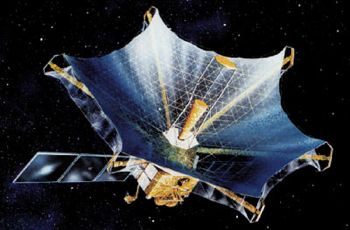
Home - Search - Browse - Alphabetic Index: 0- 1- 2- 3- 4- 5- 6- 7- 8- 9
A- B- C- D- E- F- G- H- I- J- K- L- M- N- O- P- Q- R- S- T- U- V- W- X- Y- Z
Haruka
 Haruka Credit: Manufacturer Image |
AKA: HALCA;Muses-B;VSOP. Status: Operational 1997. First Launch: 1997-02-12. Last Launch: 1997-02-12. Number: 1 .
Its 8 meter diameter radiotelescope antenna allowed very long baseline radio astronomy when used together with ground based radio telescopes of the VLBI Space Observatory Program. This resulted in very high resolution observations of deep-space radio objects. Its detectors operated at 1.6, 5 and 22 GHz.
HALCA (MUSES-B), the first astronomical satellite dedicated to Very-Long Baseline Interferometry (VLBI), was launched on its maiden flight by ISAS's M-V launch vehicle from Kagoshima Space Center.
The satellite was the second in the series of ISAS's Mu Space Engineering Satellites. Since the satellite's successful deployment, in particular the main reflector mesh, and the testing of new engineering technologies incorporated within it, such as the two-way communications link between the satellite and tracking stations, HALCA had been used for space VLBI observations.
HALCA's telescope had a main reflector with an effective diameter of 8 m, consisting of a mesh of gold-coated molybdenum wire, suspended between six extendible masts and shaped by a tension-truss arrangement. It used Cassegrain optics, with a hexagonal sub-reflector inscribed in a 1.1 m diameter circle.
The sub-reflector was deployed on 24 February 1997, and placed 3.4 m above the surface of the main reflector. Deployment of the main antenna masts took place over 26-27 February 1997. Radio waves were focused by the reflectors into a 2.5 m long feed horn. HALCA's telescope had a main reflector with an effective diameter of 8 m, consisting of a mesh of gold-coated molybdenum wire, suspended between six extendible masts and shaped by a tension-truss arrangement.
After launch, the satellite, known during its development as MUSES-B, was renamed HALCA - an acronym for the Highly Advanced Laboratory for Communications and Astronomy. HALCA was also a transliteration of the Japanese word "haruka", meaning far away, as HALCA's elliptical orbit took it out to an apogee 21,400 km above the Earth's surface, and, at the same time, it explored the mysteries of the distant universe.
The VSOP (VLBI Space Observatory Program) mission was led by the Institute of Space and Astronautical Science, in collaboration with the National Astronomical Observatory of Japan. The name VSOP reminded us of some kind of brandy, that is, "Very Superior Old Pale." The program was named by two professors who enjoyed a drink.
Family: Astronomy, High earth orbit, Radio astronomy satellite. Country: Japan. Launch Vehicles: M-V. Projects: Muses. Launch Sites: Kagoshima, Kagoshima M-V. Agency: NEC, ISAC. Bibliography: 2, 4, 6547, 12525.
1997 February 12 - . 04:50 GMT - . Launch Site: Kagoshima. Launch Complex: Kagoshima M-V. Launch Vehicle: M-V.
- Haruka - . Payload: MUSES B. Nation: Japan. Agency: ISAS. Manufacturer: NEC. Program: Muses. Class: Astronomy. Type: X-ray astronomy satellite. Spacecraft: Haruka. USAF Sat Cat: 24720 . COSPAR: 1997-005A. Apogee: 21,415 km (13,306 mi). Perigee: 569 km (353 mi). Inclination: 31.40 deg. Period: 379.30 min.
Back to top of page
Home - Search - Browse - Alphabetic Index: 0- 1- 2- 3- 4- 5- 6- 7- 8- 9
A- B- C- D- E- F- G- H- I- J- K- L- M- N- O- P- Q- R- S- T- U- V- W- X- Y- Z
© 1997-2019 Mark Wade - Contact
© / Conditions for Use